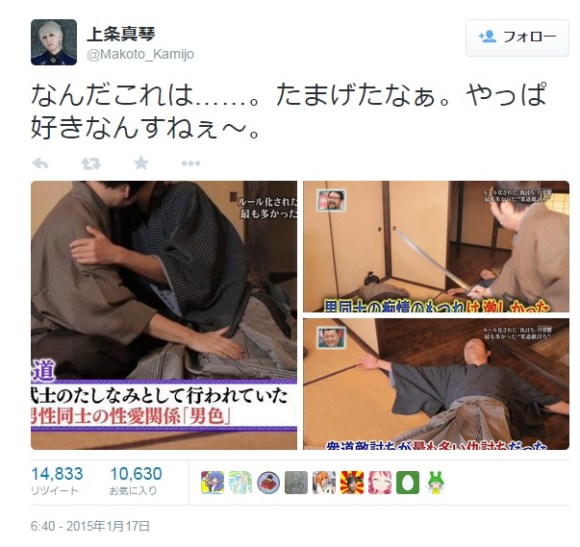
Recently a Japanese TV program highlighted an interesting bit of historical trivia: The most common type of revenge killing in the Edo period was between gay lovers. It’s a statistic that shocked many viewers in modern Japan, but there is ample evidence to support that a whole lot of gay sex was going on in the country from between 1400 and 1900.
It was at first a playful fancy of the ruling classes but then grew into a cold yet efficiently run military system of battlefield man-pleasuring. However, as we can see from the previously mentioned little factoid, once guys start letting emotions get involved, the whole thing starts to fall apart.
▼ “What is this…? Well I’ll be damned. I still like samurai though.”
https://twitter.com/Makoto_Kamijo/status/556461049667268609■ Make war not love
For well over a millennium there have been homosexual acts among the elites of Japan similar to the same master-slave relations that have occurred in many ancient societies at one point or another. By the 15th century, the custom had already carried over to the samurai classes too. It was somewhere around this time that it took the interesting euphemism of “shudo” which literally translates to “way of the people” and is the shortened from of “wakashudo” (way of the young people).
▼ Tale of Shudo (1661)
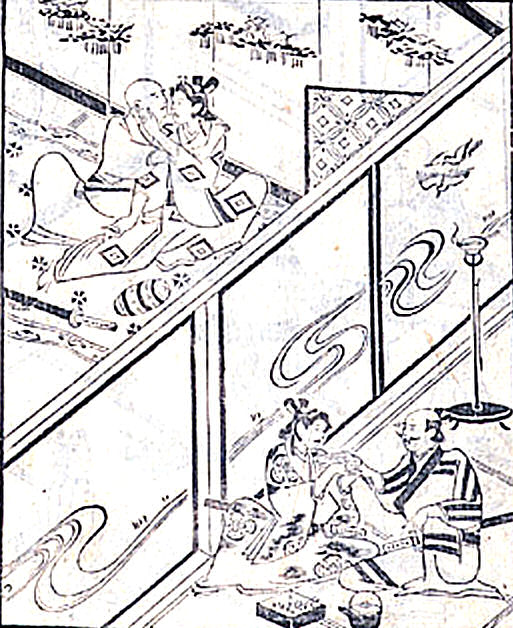
During the Warring States period over the 16th century, it became a practice for generals to keep attractive young male pages on hand for when they needed to let off some steam. It was a fairly widespread practice among warlords during the time which really puts a new spin on all those NHK period dramas. However, not everyone was on the shudo bandwagon. Mitsumasa Ikeda, a one-time lord of Himeji Castle in the early 17th century, had a strict anti-shudo policy by penalty of expulsion.
▼ Ikeda loved his subjects, just not in that way.
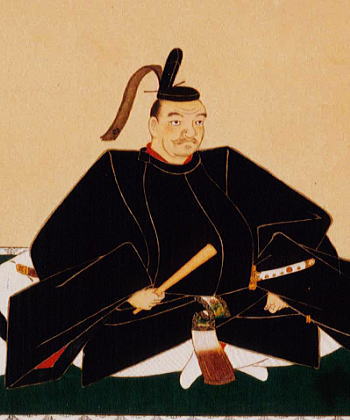
It might not be fair to call this a “gay” custom, though. It was probably more along the lines of sex between prison inmates as romance didn’t seem to play a part…yet.
■ The war is over, but the party is just starting
As the Warring States Period came to a close, the use of page-boys for homosexual sex near the battlefield became completely unnecessary, but it continued nonetheless. Some veterans seemed to have acquired a taste for danshoku, or man-on-man sex, and weren’t ready to let it go.
▼ The kanji for danshoku are the ones for “man” and “color” which is just an embarrassing Western tattoo waiting to happen.
However, a change in roles had taken place during peace-time. The original master-slave setup had evolved into a more mutual relationship. However, It retained the seniority hierarchy as found in most other parts of Asian societies like work and family with the elder man called nensha and the younger called wakashu. The whole scene was still being called shudo though…it must have made sense to the people at the time for it to stick so well.
▼ Fukuroi Station – Ando Hiroshige (1840s)
(censored out the genitalia which can be seen by clicking the image link)
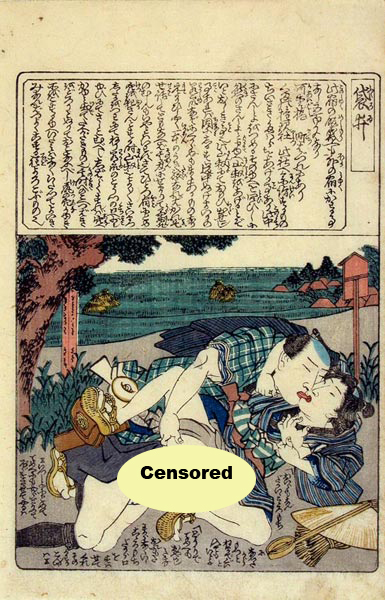
■ All fun and games until someone gets murdered
And so, homosexuality in Japan went on without too much trouble into the middle of the Edo period 1700s, but by this point it could be said that things went too far. Among the younger wakashu, one’s sexual partner had become more important to their identity than the shogun they were aligned with. As a result it led to the same sort of retaliatory violence that nationality can often do.
Love triangles would often lead to double-homicides and blood-for-blood feuds from slain lovers ensued. It grew into a major social problem and some lords began to take measures to diffuse it by cracking down on shudo in their regions. Time seemed to do the job anyway however, as shudo gradually went out of fashion and by the end of the Edo period and 19th century vanished with the last of the samurai.
Thus ended widespread homosexual culture in Japan. Nowadays, many gay men in Japan remain closeted and gay marriage seems totally off the table in government. It’s hard to say why exactly. Japan doesn’t have the religious hang-ups of other countries and most people don’t even remember the bloody history of shudo to care. But as this history lesson has taught us: Time can bring considerable change to any society. Who knows what awaits in the future?
Source: Twitter, Hamusoku, Ren-ai, Shudo Toha, Nagoya University (Japanese)

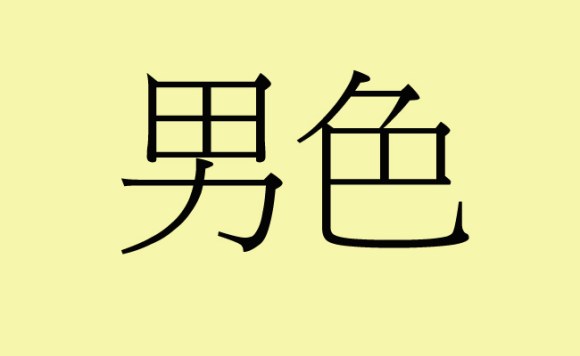
 Revealed! Japan’s top 10 handsome samurai【Photos】
Revealed! Japan’s top 10 handsome samurai【Photos】 This hotel has one of the coolest katana collections in Japan, and admission is totally free【Pics】
This hotel has one of the coolest katana collections in Japan, and admission is totally free【Pics】 Samurai Studio: Tokyo’s new photo studio where you can get your picture taken in samurai armor
Samurai Studio: Tokyo’s new photo studio where you can get your picture taken in samurai armor Women, gamers, and foreigners all show up to be samurai for a day at Sengoku battle reenactment
Women, gamers, and foreigners all show up to be samurai for a day at Sengoku battle reenactment Samurai Ninja Museum Tokyo With Experience is true to its name, lets you slice with real katana
Samurai Ninja Museum Tokyo With Experience is true to its name, lets you slice with real katana FUK COFFEE?!? Japanese cafe has a perfectly innocent reason for its startling-looking name
FUK COFFEE?!? Japanese cafe has a perfectly innocent reason for its startling-looking name Pokémon Cafe serves up a green tea ceremony in Japan with Poltchageist and Sinistcha matcha menu
Pokémon Cafe serves up a green tea ceremony in Japan with Poltchageist and Sinistcha matcha menu Japan has nearly 4 million abandoned homes, but where and why?
Japan has nearly 4 million abandoned homes, but where and why? Should married couples in Japan be allowed to have different family names? Survey investigates
Should married couples in Japan be allowed to have different family names? Survey investigates Starbucks at Shibuya Scramble Crossing reopens, but is it really bigger and better than before?
Starbucks at Shibuya Scramble Crossing reopens, but is it really bigger and better than before? Two things to do, and two things not to do, when leaving a traditional Japanese inn
Two things to do, and two things not to do, when leaving a traditional Japanese inn Japanese cosplayer creates amazing outfit: Sailor Moon’s transformation sequence!【Photos】
Japanese cosplayer creates amazing outfit: Sailor Moon’s transformation sequence!【Photos】 Bad tourist manners at Mt Fuji Lawson photo spot prompts Japanese town to block view with screens
Bad tourist manners at Mt Fuji Lawson photo spot prompts Japanese town to block view with screens The best cosplayers from Day 1 of Summer Comiket 2023【Photos】
The best cosplayers from Day 1 of Summer Comiket 2023【Photos】 Orange Juice Crisis ’24 – Japan’s OJ supplies drying up
Orange Juice Crisis ’24 – Japan’s OJ supplies drying up Foreigner’s request for help in Tokyo makes us sad for the state of society
Foreigner’s request for help in Tokyo makes us sad for the state of society McDonald’s Japan’s new pancake pie is a taste sensation
McDonald’s Japan’s new pancake pie is a taste sensation One of Japan’s oldest castles now lets travelers spend night on the grounds, drink in its keep
One of Japan’s oldest castles now lets travelers spend night on the grounds, drink in its keep Japanese city loses residents’ personal data, which was on paper being transported on a windy day
Japanese city loses residents’ personal data, which was on paper being transported on a windy day Studio Ghibli unveils new goods that tip the hat to The Cat Returns
Studio Ghibli unveils new goods that tip the hat to The Cat Returns Studio Ghibli unveils massive T-shirt collection featuring top anime movie characters
Studio Ghibli unveils massive T-shirt collection featuring top anime movie characters Japanese-style accommodation at the new Premium Dormy Inn hotel in Asakusa will blow your mind
Japanese-style accommodation at the new Premium Dormy Inn hotel in Asakusa will blow your mind McDonald’s new Happy Meals offer up cute and practical Sanrio lifestyle goods
McDonald’s new Happy Meals offer up cute and practical Sanrio lifestyle goods New definition of “Japanese whiskey” goes into effect to prevent fakes from fooling overseas buyers
New definition of “Japanese whiskey” goes into effect to prevent fakes from fooling overseas buyers Our Japanese reporter visits Costco in the U.S., finds super American and very Japanese things
Our Japanese reporter visits Costco in the U.S., finds super American and very Japanese things Japanese ramen restaurants under pressure from new yen banknotes
Japanese ramen restaurants under pressure from new yen banknotes All-you-can-drink Starbucks and amazing views part of Tokyo’s new 170 meter-high sky lounge
All-you-can-drink Starbucks and amazing views part of Tokyo’s new 170 meter-high sky lounge More foreign tourists than ever before in history visited Japan last month
More foreign tourists than ever before in history visited Japan last month New Pokémon cakes let you eat your way through Pikachu and all the Eevee evolutions
New Pokémon cakes let you eat your way through Pikachu and all the Eevee evolutions Disney princesses get official manga makeovers for Manga Princess Cafe opening in Tokyo
Disney princesses get official manga makeovers for Manga Princess Cafe opening in Tokyo Sales of Japan’s most convenient train ticket/shopping payment cards suspended indefinitely
Sales of Japan’s most convenient train ticket/shopping payment cards suspended indefinitely Sold-out Studio Ghibli desktop humidifiers are back so Totoro can help you through the dry season
Sold-out Studio Ghibli desktop humidifiers are back so Totoro can help you through the dry season Japanese government to make first change to romanization spelling rules since the 1950s
Japanese government to make first change to romanization spelling rules since the 1950s Ghibli founders Toshio Suzuki and Hayao Miyazaki contribute to Japanese whisky Totoro label design
Ghibli founders Toshio Suzuki and Hayao Miyazaki contribute to Japanese whisky Totoro label design Doraemon found buried at sea as scene from 1993 anime becomes real life【Photos】
Doraemon found buried at sea as scene from 1993 anime becomes real life【Photos】 Tokyo’s most famous Starbucks is closed
Tokyo’s most famous Starbucks is closed One Piece characters’ nationalities revealed, but fans have mixed opinions
One Piece characters’ nationalities revealed, but fans have mixed opinions We asked a Uniqlo employee what four things we should buy and their suggestions didn’t disappoint
We asked a Uniqlo employee what four things we should buy and their suggestions didn’t disappoint Now’s your once-in-12-years chance to order this special $850 pot of pickled plums!
Now’s your once-in-12-years chance to order this special $850 pot of pickled plums! Samurai C-3PO is the Japanese warrior droid we’ve all been waiting for
Samurai C-3PO is the Japanese warrior droid we’ve all been waiting for Samurai Toothpicks with bite-sized language lessons will help you look and sound like a swordsman
Samurai Toothpicks with bite-sized language lessons will help you look and sound like a swordsman 11 predictions Japanese people made hundreds of years ago about the future
11 predictions Japanese people made hundreds of years ago about the future Champion figure skater Yuzuru Hanyu to make on-screen acting debut as samurai lord!
Champion figure skater Yuzuru Hanyu to make on-screen acting debut as samurai lord! LDP deems gay rights legislation ‘unnecessary’ according to multi-party survey
LDP deems gay rights legislation ‘unnecessary’ according to multi-party survey Tokyo’s new samurai photo studio sends you to Japan’s feudal era with awesome digital backdrops
Tokyo’s new samurai photo studio sends you to Japan’s feudal era with awesome digital backdrops These 19th-century Japanese miniature landscapes show that size isn’t everything
These 19th-century Japanese miniature landscapes show that size isn’t everything This Valentine’s Day, wow your special someone with boozy samurai warlord chocolates!
This Valentine’s Day, wow your special someone with boozy samurai warlord chocolates! Critically acclaimed A-bomb manga Barefoot Gen excerpts removed from Hiroshima school curriculum
Critically acclaimed A-bomb manga Barefoot Gen excerpts removed from Hiroshima school curriculum Foreign tourists pick the top 10 must-visit museums in Japan
Foreign tourists pick the top 10 must-visit museums in Japan Japanese restaurant from the Edo Period forced to close due to coronavirus pandemic
Japanese restaurant from the Edo Period forced to close due to coronavirus pandemic Survey claims that 30 percent of boys’ love fans in Japan are men
Survey claims that 30 percent of boys’ love fans in Japan are men Breaking Fujoshi: Twitter user tries to unlock the code to girls who grow up “rotten”
Breaking Fujoshi: Twitter user tries to unlock the code to girls who grow up “rotten” Fight like a ninja in a samurai town, with sword-fighting experience at Kyoto Toei movie studio park
Fight like a ninja in a samurai town, with sword-fighting experience at Kyoto Toei movie studio park
Leave a Reply